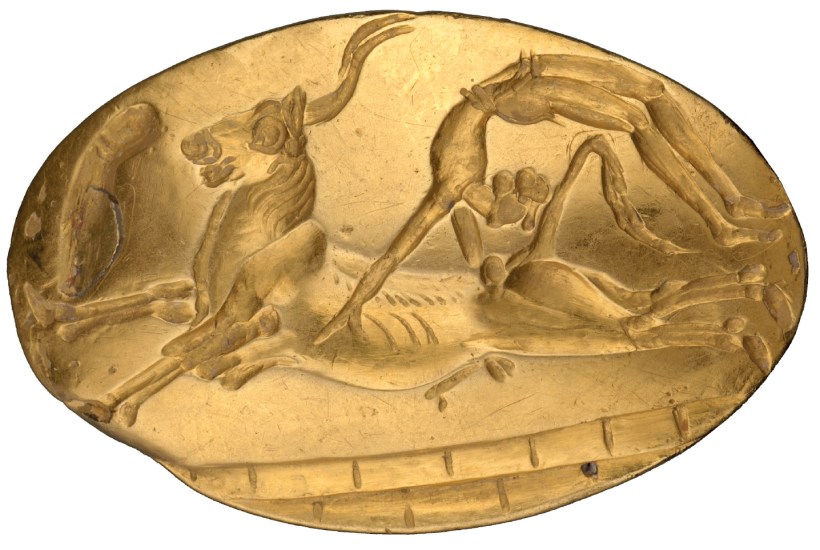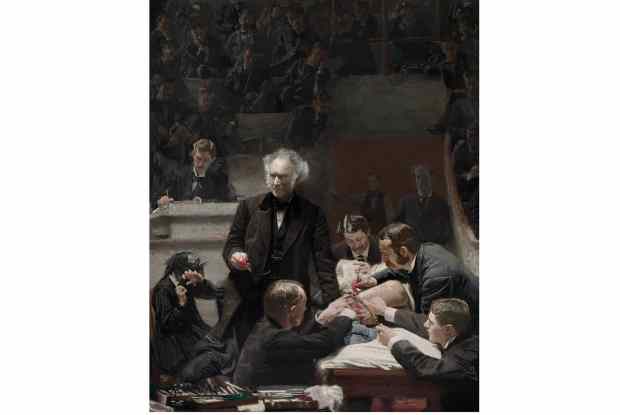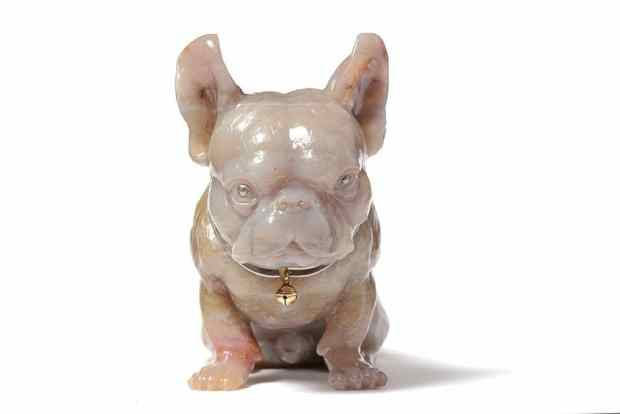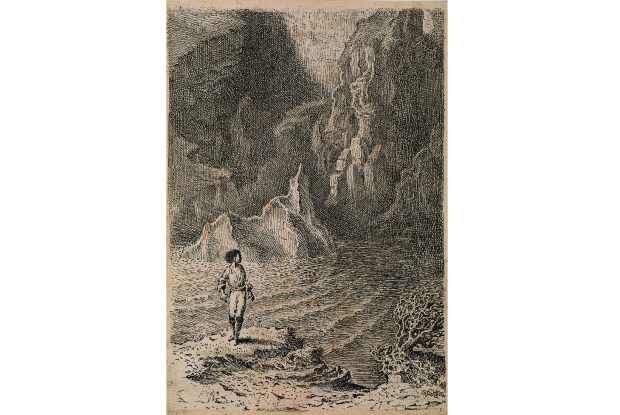Labyrinth: Knossos, Myth & Reality at the Ashmolean Museum in Oxford does not take the idea of a labyrinth too literally. It does not lead you through galleries to dead ends, nor are you left searching, like Theseus, for a ball of thread to find your way out again. The real enigma of the exhibition revolves around the Bronze Age civilisation at its heart.
The Minoans, who occupied Crete between about 3,000 and 1,100 BC, remain some of the most mystifying people ever to have been stumbled upon in modern times. It is uncertain where they came from, what they believed, how they were governed and why they chose to paint things the colours they did in their dynamic works of art. They traded widely, including with Egypt, but the direction of cultural influence is not always clear. When I put it to Dr Andrew Shapland, curator of the exhibition, that the Minoans throw up more questions than answers, he assures me that bewilderment is often the prevailing emotion among scholars of the period as well. Not even their principal writing script, Linear A, has been deciphered fully.
The material the Minoans left behind inspires deep, obsessive wonder. Figures of bare-breasted women with snakes writhing around their arms and elaborate headpieces accompany pots painted with massive octopuses and frescoes filled with blue monkeys, crocuses and long-haired, red-skinned men. Many of the paintings were heavily restored in the early 20th century, with heads and sometimes entire figures recreated controversially from scratch. Most were copied from more complete examples, but it has been observed that in some instances, the women look peculiarly modern. One of the best-preserved ‘original’ panels shows a lithe man with his face still intact and full of life, his neck extended as he leans back upon himself, waist cinched, arms akimbo.
Few subjects are as prevalent in Minoan art as the bull, which features on everything from drinking vessels to wall crenelations. The Minoans evidently believed that bulls possessed some potency. By contrast the inhabitants of classical Greece – who succeeded the Minoans – would routinely offer up their livestock to the gods without revering them to such a degree. Some of the most striking Minoan pieces show men leaping over bulls. The exhibition presents a particularly thrilling interpretation of the act, the ‘Taureador Fresco’, a restored painting of a man catapulting himself over the torso of a very long-bodied bull, while two further figures participate in the feat from either end of the animal. One holds the bull’s horns while the other prepares to aid the acrobat in his dismount. Why they had this obsession with bull acrobatics is yet another mystery.
Bulls became synonymous with Crete thanks in part to the myth of the Minotaur. Pasiphaë, queen consort of the island, was said to have had sex with a bull by hiding inside a wooden cow, after Poseidon made her fall in love with the animal. She commissioned the craftsman Daedalus to carve a carapace especially. The mechanics of what followed were wisely left to the imagination, but the product of the liaison, the Minotaur, quickly became infamous. Pasiphaë’s husband King Minos ordered Daedalus to construct a labyrinth around the bull-man at Knossos, where the beast feasted on teenagers sent to him from Athens.
The rediscovery of the site of Knossos on Crete in the late 19th century sparked a romantic search for remains of the labyrinth. The archaeologist Sir Arthur Evans might not have been so impressionable as to believe that the hybrid creature existed, but the sight of a palatial complex emerging from the soil convinced him that he was standing upon the very threshold of Minos, the cuckolded king of legend.
Labyrinths were real. They had appeared on ancient coins and works of art for thousands of years. And according to Herodotus, one was built just outside the splendidly named Crocodilopolis, south of Cairo, near Faiyum in Egypt. It allegedly contained 3,000 chambers, half of them subterranean, and was predictably nightmarish to navigate. The foundations of a building of a similar description have been found in the region and identified as part of the intricate mortuary temple of Amenemhat III, a pharaoh of the 12th dynasty.
What Evans found in Crete was a palace that resembled a labyrinth. The ground plan of the ‘Second Palace’ at Knossos, a site first discovered by the Greek amateur archaeologist and businessman Minos Kalokairinos, is as twisting and convoluted as any monster’s lair. Workshops, storage rooms and private living quarters sprout from gymnasium-like courts and seemingly infinite passageways. While it is unlikely that the Minoans drew a direct connection between their palaces and the concept of a labyrinth, the earliest representation of a Cretan labyrinth so far discovered is square, and the turnings of the Second Palace echo the corridors on it. This plan, appearing on the back of a writing tablet dated to about 1,200 BC and discovered on mainland Greece, shows a single path to the centre and seven layers to meander through. Coins minted from the 5th century BC, when the Minotaur myth was famous throughout Greece, often replicated this square design.
The Minotaur itself was, unsurprisingly, more elusive than the labyrinth. It is seldom observed that the bulls depicted in Minoan artworks tend to be very different from the beasts imagined by later artists. There is nothing Minotaur-like about them. Compare the bull in the ‘Taureador Fresco’ with the formidable Roman-era marble sculpture that confronts you upon entering the exhibition (see below) and you could almost call the former cute. Where Greek vase painters, Roman sculptors and Picasso in his famous series exploited the raw violence of the Minotaur, the Minoans seem to have recognised the bull’s propensity for taming and being tamed. There is nothing to say that young Minoan men were not taught to master bulls and leap over them as a means of mastering themselves.
From what we know, the closest the real-life Minoans came to re-enacting the deeds of Theseus, who arrived from Athens to slaughter the Minotaur with help from Ariadne, Pasiphae’s daughter, was in their performance of religious sacrifice. There is evidence of the ritual killing of bulls on Crete and also, more rarely yet grotesquely, of humans, including children. The latter was confirmed by the discovery of healthy juvenile bones bearing cut marks. Some believe that human sacrifices were carried out to ward off natural disasters such as earthquakes.
Minoan Crete was once associated with the utopian kingdom of Atlantis, which Plato described as flourishing, and then sinking, inspiring a thousand fruitless quests for its whereabouts. The Ashmolean exhibition sensibly stops short of exploring that myth in favour of revelling in the vibrancy, colour and wonderful weirdness of Minoan life.
Perhaps the most astonishing thing about the Minoans is that we know anything about them at all, given that they’re a millennium older than Homer, the earliest western literary source. The story of how they came to be may be as remote as the birth of the Minotaur, but they cut a unique and unerring path as they painted and sculpted the world as they saw it.
Got something to add? Join the discussion and comment below.
Get 10 issues for just $10
Subscribe to The Spectator Australia today for the next 10 magazine issues, plus full online access, for just $10.
You might disagree with half of it, but you’ll enjoy reading all of it. Try your first month for free, then just $2 a week for the remainder of your first year.














Comments
Don't miss out
Join the conversation with other Spectator Australia readers. Subscribe to leave a comment.
SUBSCRIBEAlready a subscriber? Log in